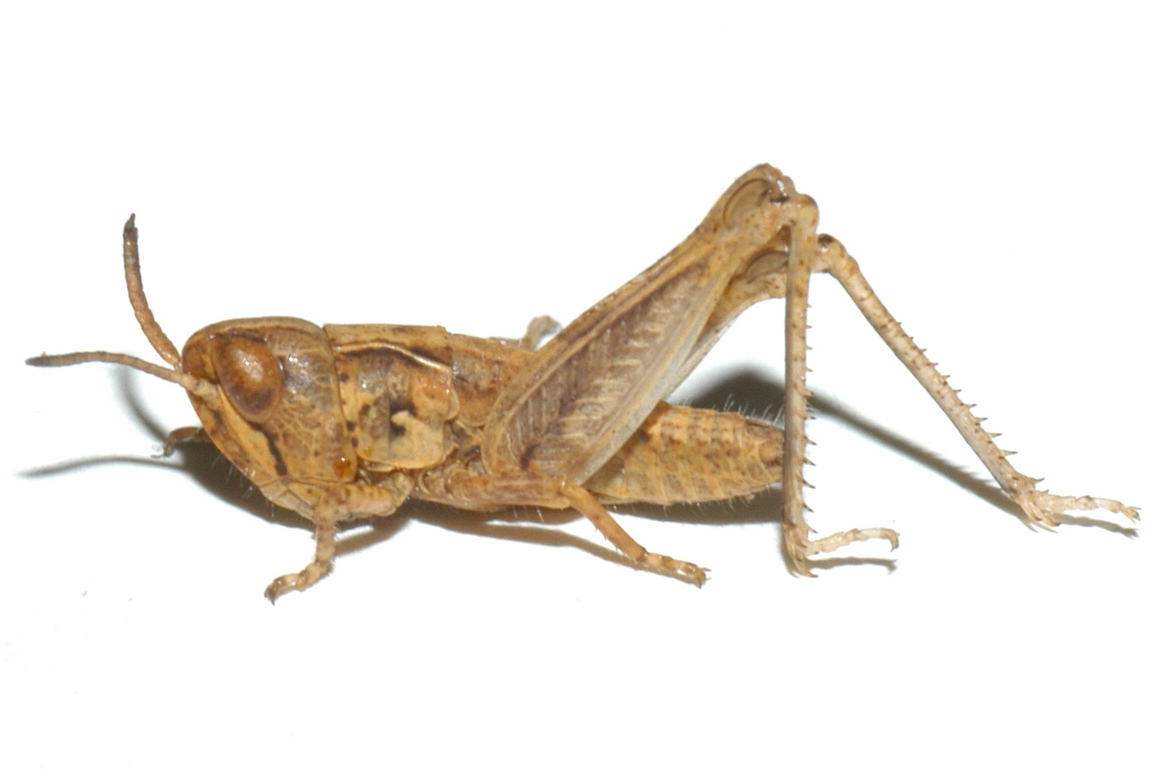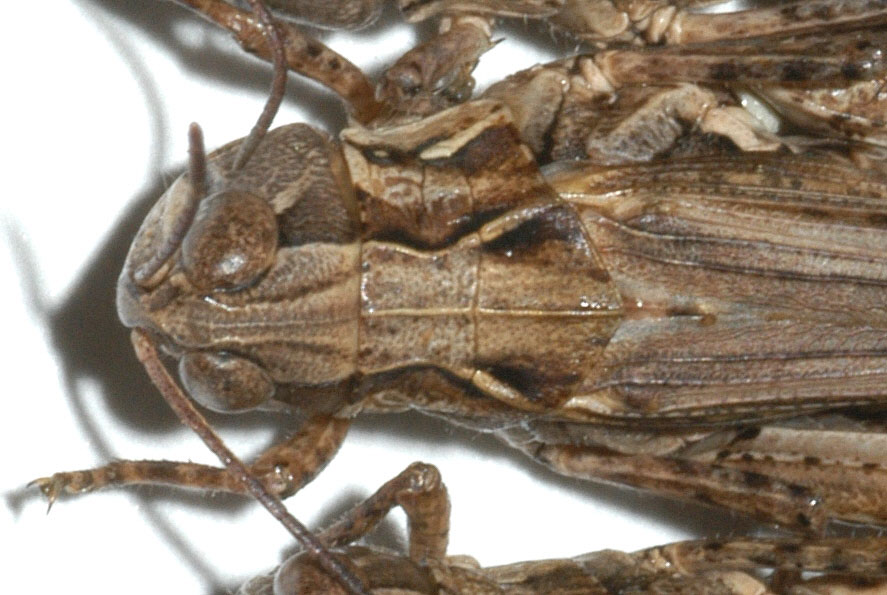Psoloessa texana
|
Geographic range of Psoloessa texana Scudder
|
|
Fig. 1, first instar |
|
Fig. 2, second instar |
|
Fig. 3, adult male: BL 15-18 mm, FL 8-10 mm, AS 21-23 |
|
Fig. 4, adult female: BL 17-22 mm, FL 9-14 mm, AS 21-24 |
|
Fig. 5, dorsal view of pronotum |
Species
Texas spotted range grasshopper
Psoloessa texana (Scudder)
Subfamily Gomphocerinae
Identification
Adults of Psoloessa texana are small, colored with various shades of brown in a variety of color patterns. It is very similar to the brownspotted grasshopper but generally more variable in appearance. It can be differentiated by a number of characters. As in the brownspotted grasshopper, the lateral carinae of the pronotum are cut by one sulcus, however, it lacks distinct depressions where the sulcus cuts the carinae. In most cases, the abdomen of Psoloessa texana is brilliantly salmon orangish in color, while in the brownspotted grasshopper it is light brown to yellowish brown. The outer surface of the hind femur is light brown, most often with one or two dark marks along the dorsal edge. The inner hind femur is brown with some dark suffusion extending from dark markings dorsally. The hind tibiae are light brownish to tan, and never orange or reddish as in P. delicatula. The ground color of the head, pronotoum, and tegmina is highly variable, with some individuals being nearly un marked light brownish while others are boldly marked with a thick dark stripe on the sides of the head and pronotum. As in the brownspotted grasshopper it most often has a tiangular mark on the upper marginal area of the hind femur. It too has lateral foveolae squared to sometimes triangular.
Distribution and habitat
Psoloessa texana is primarily a southwestern species, occurring from Nebraska and South Dakota to California, Texas, and into Mexico. It occurs on bare ground with scanty vegetation, coastal dunes, edges of dunes and blowouts, and other open sandy areas. It is an abundant desert-floor species in the southwest and occurs up to 8,000 feet in elevation. In Texas it is abundant in grasslands. Within rangeland, it is most numerous in and near blowouts, and in overgrazed sandy areas.
Economic importance
Because it seldom occurs in high densities, it is unlikely to cause damage. Its early season occurrence limits the number of grasshopper species with which it will contribute damage, and it might contribute to minimal damage alongside the velvetstriped grasshopper. While it seldom reaches large numbers locally, it can be important in range because it feeds to a large extent on germinating seeds, generally preventing revegetation of range.
Food preferences
The food habits of this grasshopper have not been studied in detail. Like the other common member of its genus, the brownspotted grasshopper, it probably feeds on grasses and sedges. It apparently feeds readily on germinating seeds.
Dispersal and migration
The dispersal habits of P. texana have not been studied in detail, but it does have comparatively long wings and may be capable of sustained long flights. However, its consistent occurrence in somewhat barren sandy areas suggest it is very habitat specific and only migrates rarely.
Hatching
Eggs of Psoloessa texana hatch during the summer in Nebraska.
Nymphal development
Nymphs likely overwinter in the forth or fifth instar. Nymphs resume development in March and April and reach adulthood in April and May.
Adults and reproduction
Adults occur in the same areas in which the nymphs presumably develop. During courtship, male approach females and produce stridulatory songs of three different types. In many cases, this song consists of a groups of three to four sharp tick-like pulses. In some areas adults have been reported as occurring from midsummer to fall, but in Nebraska, adults are found early in the season, with peak numbers from late April to early June.
Population ecology
The population ecology of this grasshopper has not been studied in detail.
Daily activity
This species typically inhabits areas of bare ground, but often retreats to low vegetation and shade during the heat of the day. Little else has been recorded about its daily activity.
Source and date
University of Nebraska March 2007 by Mathew L. Brust
Selected references
Ball, E. D., E. R. Tinkham, R. Flock, and C. T. Vorhies. 1942. The grasshoppers and other Orthoptera of Arizona. Arizona Agriculture Experiment Station Technical Bulletin 93: 255-373.
Otte, D. 1970. A comparative study of communicative behavior in grasshoppers. Miscellaneous Publications of the University of Michigan Museum of Zoology no. 141: 1-168.
Otte, D. 1981. The North American grasshoppers, Volume I, Acrididae: Gomphocerinae and Acridinae. Harvard University Press, Cambridge, Massachusetts. 368 pp.
Otte, D., and J. A. Joern. 1977. On feeding patterns in desert grasshoppers and the evolution of specialized diets. Proceedings of the Academy of Natural Sciences of Philadelphia 128: 89-126.
Tinkham, E. R. 1948. Faunistic and ecological studies on the Orthoptera of the Big Bend Region of Trans-Pecos Texas, with especial reference to the Orthopteran zones and faunae of midwestern North America.




